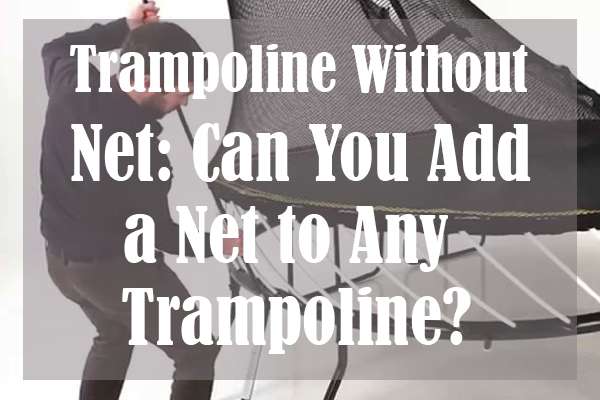
Trampoline Without Net: Can You Add a Net to Any Trampoline?
Trampolines have become extremely popular and favored in recent years, especially by children. Not only is bouncing up and down a fun and thrilling activity for them but it also serves as a form of exercise. However, this thrilling experience might come off as dangerous as well. The lack of a safety net is what causes injuries in 95% of situations. Without it, the children are at risk of spine, neck, and head injuries and fractures. Therefore, it’s imperative to value the child’s safety over everything else and have a safety net installed.
But what if a trampoline that we bought doesn’t come with a safety net? What do we do then? Do we simply return the trampoline without the enclosure and buy another one? Well, we can affirm that returning the trampoline and asking for a refund isn’t completely necessary. It is possible to add a customized safety net, and we’ll explore that idea in this article.
Is Adding Your Own Net Possible?

People who already purchased a trampoline without the safety enclosure often wonder whether they can add one later on. Well, the answer is yes. Depending on the type of trampoline that we have, we can either purchase a safety net that goes around it or attach one ourselves. If we’re sticking to the DIY method (attaching it ourselves), there are a couple of things to pay attention to. We’ll cover the exact particulars of the procedure in the following sections.
Additionally, we need to know what type of a safety net we want before we decide to attach it to the trampoline frame.
What to Look for in a Safety Net

In order to attach everything properly, we need to know what we’re operating with first. That means selecting a safety enclosure that’s compatible with the trampoline model that we have. To help our readers in that regard, we’ve assembled a short list of factors that they should pay attention to.
Weight
The weight of a safety net basically determines its longevity and how strong it actually is. In addition, it’s one of the factors that affect how safe the children will be. For example, safety nets that weigh less are easier to topple over or bend/break after frequent use. Heavier nets have some bulk to them, meaning that they have better wear and tear properties.
Door
The door is often the only thing that people see as a weak point of the safety enclosure. When we’re looking for a good safety net, we need to make sure that it offers a secure door. The last thing we want to happen is to see someone bounce off the trampoline through the door.
So, which doors are good and which aren’t? There are some safety nets out there that have doors which resemble curtains, and it’s important to avoid those. On the other hand, safety net doors with heavy-duty zippers will do the job just fine.
UV Protection
If there’s one thing that constantly keeps damaging our trampolines over time, then it’s definitely the sun. We know of numerous cases where trampolines broke down completely due to long exposure to the sun. Safety nets are no different in that matter. That’s why it’s important to look for safety nets that have some sort of UV protection.
Weave
Our final factor to look for is the weave of the net. Let’s consider the fact that safety nets are prone to damage. It’s quite common to see tears in a safety net because they’re not built to last forever. However, we can minimize the occurrence of those tears by installing a safety net with a heavy-duty weave. It also provides an additional boost to durability and protection of the net.
How to Put a Safety Net on a Trampoline

Now, some of the steps in this section might be different for some people but the basic principle is always the same. The only thing that can slightly alter the order of the steps here is the model and design of the safety net.
The first thing to do when it comes to installing a safety net is to take out the steel/aluminum tubes from the package and put them together. They are quite easy to assemble and attach because they connect to the legs of the trampoline. We need to make sure to slide the smaller tubes into the larger notched tubes. Afterward, we’ll have to attach the tubes to the base of the trampoline and screw them in place.
The next step is to attach the balls that will hold the net to the top of the poles. To do that, we need to slide the webbed portion of the net through each ball. There are designated points where the net attaches to the balls. Once we find those, we should tie them and stretch out the net around the poles. There should be at least three loops for each pole.
The only thing that’s left to do is to inspect the safety enclosure to see if everything is aligned properly. That’s it; we’re good to go.
Final Words
We hope that our article was of some help to our readers. The methods that we showcased are the ones most commonly used by people. However, we understand that there might be a different way of achieving the same results.
If you liked our article, it would mean a lot to us if you could share it with your friends. Also, be sure to leave us a comment because we’re always interested to hear your thoughts. Thank you for reading.

